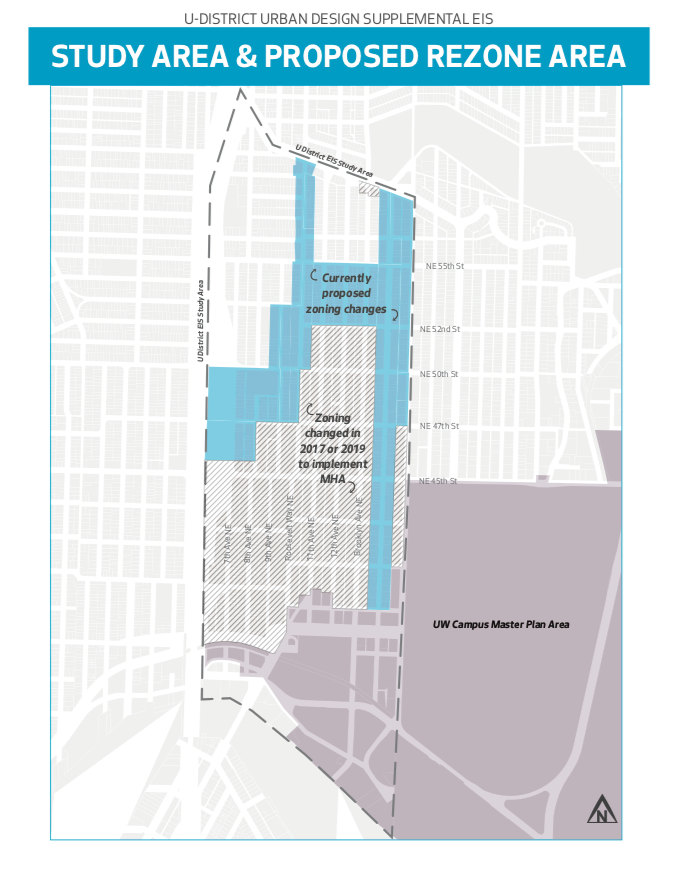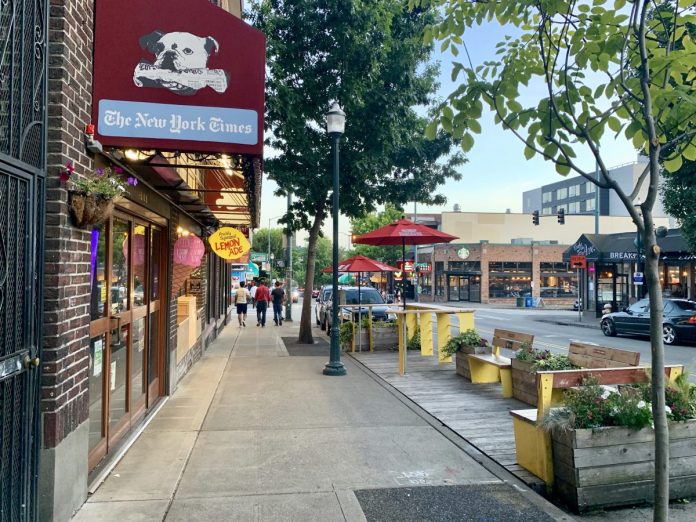There is probably not much that District 4 City Council candidates Shaun Scott and Alex Pedersen agree on, but one topic on which the opponents seem to see eye-to-eye is the future of University Way, better known as The Ave. Both candidates have come out publicly against upzoning The Ave under the Mandatory Housing Affordability (MHA) program.
“We agree on a very important policy matter affecting our district: the current city council should indefinitely suspend its plan to up-zone ‘The Ave,’” Scott and Pedersen wrote in a co-signed letter to city hall that was first reported by The Stranger.
The Ave, which is one of the most pedestrian-friendly commercial districts in Seattle, lies right in the heart of the University District urban village, one of the first urban villages to be upzoned under MHA back in 2017–although The Ave was taken out of the upzone following community pushback. Since the implementation of upzones, hundreds of units of new housing have been added to the neighborhood and millions of dollars have been contributed toward affordable housing through MHA affordability requirements.
Near the future Link light rail station at Brooklyn Avenue NE and NE 45th Street, and a new wave of highrise developments is in the works, some like the tower planned at 1200 NE 45th Street shown in the rendering below, will rise 24 stories in height, on par with UW Tower across the street.

High density residential development is usually considered complimentary to pedestrian friendly shopping districts like The Ave. But in the U District, for some longtime business owners and residents, the sudden growth has catalyzed fears of displacement.
When Scott and Pedersen submitted their letter to City Council asking for council members to “indefinitely suspend its plan to up-zone the ‘Ave,'” they were expressing their support for a group of U District businesses called Save The Ave that rallied back in 2017 and succeeded in convincing the City Council to exempt The Ave and some neighboring streets from being rezoned under the MHA program.
Save The Ave scored a second win this spring when it convinced the City Council to extend the exemption for The Ave during the citywide rollout of MHA.

However, the exemption continues to be temporary, and the City is now preparing for a Supplemental Environmental Impact Statement (SEIS) that will study the potential impacts of upzones on the area.
In what appears to be a move toward compromise, the City is contemplating a different path forward for new development in the U District, and as part of that process it is gathering information from the public through a short survey. The information gathered will be used to create a “community generated alternative” that will be studied in the SEIS alongside the existing No Action alternative, which would not make zoning changes or implement MHA, and an alternative that implements MHA with a one-to-two story increase on The Ave.
The City’s survey also includes ideas on for how to preserve the U District’s character as a commercial district and guide future growth.
Idea 1: Special District on The Ave
The first idea floated by the City is to create a conservation overlay or special district that incentivizes the preservation of structures and existing small business spaces on The Ave. The special district would apply for lots on The Ave between NE 41st Street and NE 50th Street. In this area, zoning would be reduced on The Ave from 65 to 45 feet.
Preservation of neighborhood character would be emphasized in the special district. Building owners would be offered incentives to preserve character structures or facades. New infill development on sites without character structures would be encouraged, but developers would near to adhere to design standards such as narrow storefront widths and setbacks from the sidewalk.

To aid in the preservation of character buildings, owners would be able to transfer their development rights outside of the district.
But defining exactly what constitutes a “character structure” might be sticky point for this concept, particularly if the emphasis is on preventing displacement of small businesses. Some buildings that are not viewed as contributing to the character of the neighborhood might offer lower rents than character buildings.
Furthermore, the reduction of building heights from 65 feet to 45 feet would reduce housing created on new infill developments, and the exemption from MHA would eliminate contributions to affordable housing from new development in the area.
Under the City’s MHA proposal, building heights on The Ave would increase from 65 feet to either 75 feet or 85 feet–a difference of one to two stories of buildable height.
A proposed infill development on The Ave at NE 52nd Street illustrates what might be lost through an MHA exemption for the area. Current building plans are for a six-story structure (65 feet) that would contribute 89 units of housing with retail space on the ground floor. Under the City’s proposed MHA zoning, the building would only rise one to two stories higher, and it would be subject MHA requirements to contribute to affordable housing.

Idea 2: More housing near University Playfield
Not all of the City’s proposed concepts for the U District are focused on reducing housing capacity; in fact in the survey the City presents the idea of increasing zoning heights from Lowrise 1 and 2 to Midrise near the University Playfield, which is located a few blocks west of The Ave near the intersection of Roosevelt Way and I-5. Concerns about safety and lack of activation around University Playfield are part of the motivation for increasing zoning in this area, and building designs would need to be intended to increase activity both in the park and nearby alley at 7th Avenue NE.
The City has also proposed increasing the MHA affordable housing contributions for building in this area to reflect the increase in zoning capacity.

Idea 3: More housing on the Roosevelt Way corridor
Adding housing along Roosevelt Way, an arterial with fewer historic structures than The Ave, has also been targeted by the City as means to help reduce possible reduction of future housing on The Ave. The City has proposed increasing zoning on Roosevelt from the current five stories to six or seven stories.

However, shallow lots on Roosevelt might make it difficult to permit taller structures in much of this area unless the zoning area is increased on some adjacent streets. To help solve this issue, the City has also suggested a “stepped transition” from nearby Lowrise-zoned areas.
Idea 4: Taller towers in the U District core area
In the areas of the U District where highrise development has already been zoned, several highrise developments are already in the works. However, the City is suggesting further raising the heights from 240 feet to 320 feet in all of the U District core area.

However, similar to plans to increase housing capacity on Roosevelt Way, the size of lots would restrict how many buildings would be able to rise above current zoning.
Idea 5: Delay action for another 5 years
The last idea put forth in the City’s survey is delay any further zoning changes in the area for another five years. Development in the U District would continue to happen under existing zoning, but without MHA’s affordability housing requirements. There is existing zoning that is already sufficient to support redevelopment in some cases, so the district could still be losing existing storefronts in the interim while getting no affordability in return.
In sum, the increased delay would give the City more time to study the effects of delaying MHA implementation for each alternative, but it would reduce contributions for affordable housing and could also lead to land speculation.
What do you think about the proposed concepts? Do you have additional ideas about how to guide the U District’s future? If so, complete the City’s survey by midnight Wednesday September 25th.
We’re in our fall subscriber drive so please consider a donation.
Natalie Bicknell Argerious (she/her) is a reporter and podcast host at The Urbanist. She previously served as managing editor. A passionate urban explorer since childhood, she loves learning how to make cities more inclusive, vibrant, and environmentally resilient. You can often find her wandering around Seattle's Central District and Capitol Hill with her dogs and cat. Email her at natalie [at] theurbanist [dot] org.



